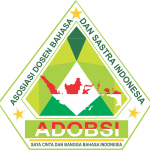LEXICAL ITEMS IN BATAK TOBA LANGUAGE REPRESENTING FAUNA, FLORA, AND SOCIAL ENVIRONMENT: ECOLINGUISTICS STUDY
Abstract
In the ecolinguistic view, the relationship between human and nature (ecology) produces a variety of languages (linguistics). Language and environment are two things that influence each other. Change in language, both in the lexicon or grammar, cannot be released from changes in the natural and social environment. On the one hand, environmental changes have an impact on change in language, and on the other hand, the community behavior towards their environment influenced by the language they use. Thus, the dynamics of the existence of the lexicon are affected by changes in the environment of a place the language used. The results of this study prove that there is relationship between language and nature. There are 6 lexicons which be explained in this article. Horbou or buffallo and Dekke or fish: goldfish are lexical items representing fauna. Boras Sipir ni Tondi or Rice and Demban or Sirih or betel leaf are lexical items representing flora. And to the lexical items which representing social environment are Ulos or Woven Cloth and Tortor or Traditional Dance. The six lexical items which are representing natural (two for fauna and flora respectively) and social environment (two lexical items) contain cultural terms in Batak Toba language. Because it is a cultural term, then it cannot be separated from the history of Batak people. The cutural terms then will be analyzed and compared to the present life in Indonesian culture in general. It could have similarities or even differences to the present life in Indonesia.
Keywords
Full Text:
PDFReferences
Agus Subiyanto, 2013, Ekolinguistik: model analisis dan penerapannya, [online] Dapat diakses lewat situs : www. portalgaruda.org
Ajip Rosidi, 2004, Babasan & Paribasa Kabeungharan Basa Sunda 1, Kiblat Buku Utama, Bandung
Ajip Rosidi, 2009, Babasan & Paribasa Kabeungharan Basa Sunda 2, Kiblat Buku Utama, Bandung
Bang, J.Chr. dan Door, J. (1993). Eco- Linguitics: A Framework. [online] Dapat Di akses lewat situs: www.jcbang.dk/main/ecolinguistics/ Ecoling_AFramework1993.pdf
Haugen, E. (1972). “The Ecology of Language”. dalam Dil, A.S. (ed) The Ecology of Language: Essays by Einar Haugen. Stanford: Stanford University Press
Halliday, M.A.K. (1990). “New Ways of Meaning: The Challenge to Applied Linguistics”. Dalam Journal of Applied Linguistics 6 :7-36
Halliday, M.A.K. (2001). “New Ways of Meaning: The Challenge to Applied Linguistics”. Dalam Fill, A. dan Muhlhausler, P. The Ecolinguistics Reader: Language, Ecology, and Environment. London: Continuum
Mbete, Aron Meko. 2009. “Refleksi Ringan Tentang Problemantika Keetnikan dan Kebahasaan dalamPerspektif Ekolingistik”. Makalah Seminar Nasional Budaya Etnik III, USU Medan, 25 April 2009
Refbacks
- There are currently no refbacks.






